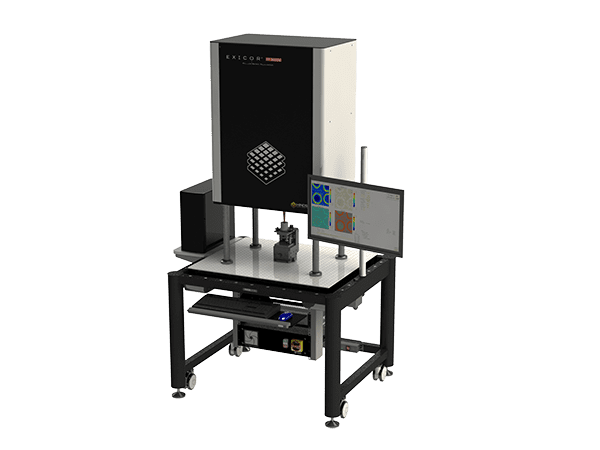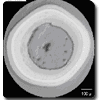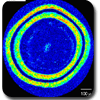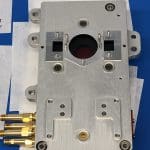Optical Anisotropy Factor Measurement System

2-MGEM Optical Anisotropy Factor Measurement System
Request QuoteDeveloped in cooperation with Oak Ridge National Laboratory, a new instrument is advancing the understanding of 4th Generation nuclear fuels and reflected polarization characteristics.
The 2-MGEM Optical Anisotropy Factor Measurement System is a normal-incidence polarization reflection microscope designed to measure the sample Mueller matrix and is a 2008 R&D 100 Award Winner.
This system is designed specifically to evaluate the Optical Anisotropy Factor (OPTAF) of cross sections of TRISO nuclear fuel pyrocarbon layers. Other possible material characterizations include measuring Mueller matrix elements of other crystals, carbon compounds, and thin film coatings (e.g. surface deposition films) at normal incidence.
The 2-MGEM can also measure retardation (d), circular diattenuation (CD), and the polarization factor (ß). These parameters are not measurable using older techniques, since those techniques do not incorporate a compensating optical element.
Contact us for more information about the 2-MGEM system and to learn how Hinds Instruments works with our customers to solve complex metrology problems.
Measuring TRISO:
Understanding the preferential orientation of the graphite in TRISO inner pyrocarbon (IPyC) and outer pyrocarbon (OPyC) coating layers can identify formation orientation issues that will lead to premature failure of the containment.


2-MGEM Ellipsometer Product Bulletin
Licensed from UT-Battelle, LLC, management and operating contractor of the Oak Ridge National Laboratory, under Patent License Agreement No. 972.
Advantages of measuring TRISO particles with the Hinds Instruments 2-MGEM:
- No sample rotation is needed.
- 2-MGEM data is taken as a function of x- and y- position, making it possible to construct an image of the various measured parameters. All of the previous techniques are only able to measure at single points.
- Optical resolution <4 microns
- The 2-MGEM measures 8 parameters, which can then be reduced to the diattenuation N and the principal direction. The quantities N and cannot be measured simultaneously using any of the older techniques.
- The 2-MGEM measures each of the 8 parameters to ~0.001; previous measurements of OPTAF were accurate to ~0.01. The 2-MGEM is 10 times more accurate. This accuracy is critical because the variations in the diattenuation from processing conditions are often as small as 0.002.
System Details
Custom configurations and accessories are available for these models. Please contact a representative for more details.
Resources
Product Bulletin
Dimensions
Worldwide Offices
Africa
Hinds Instruments, Inc.
7245 NE Evergreen Pkwy
Hillsboro, OR 97124
USA
Phone: 1.503.690.2000
Fax: 1.503.690.3000
Email: sales@hindsinstruments.com
Americas
Hinds Instruments, Inc.
7245 NE Evergreen Pkwy
Hillsboro, OR 97124
USA
Phone: 1.503.690.2000
Fax: 1.503.690.3000
Email: sales@hindsinstruments.com
India
Laser Science Services (I) Pvt. Ltd.
Offices in Navi Mumbai, Chennai, Delhi, Kolkata
Head Office:
A-454, TTC Industrial Area
MIDC, Mahape
Navi Mumbai, 400 710
INDIA
Phone: 91-22-41553232
Fax: 91-22-27781672
Email: sales@laserscience.in
Website: http://laserscience.co.in/
Japan
Tokyo Instruments Inc.
Attn: Mr. Ryutaro Shimada
T.I.Building,
6-18-14 Nishikasai Edogawa-Ku,
Tokyo 134-0088
JAPAN
Phone: +81 3 (3686) 4711
Fax: +81 3 (3686) 0831
Email: sales@tokyoinst.co.jp
Website: https://www.tokyoinst.co.jp
PR China (Integrated Components)
Aunion Tech Co Ltd – China HQ
Attn: Jinlong Wu
3rd Floor, Building 6,
2007 Hongmei Road,
Xuhui District, Shanghai, 200233 P.R. China
Phone: +86-21-51083793
Fax: +86-21-34241962
URL: www.auniontech.com
Aunion Tech Co Ltd – Shenzhen Branch
Attn: Mary Ma
Phone: 182-2167-2726
Email: lili-ma@auniontech.com
URL: www.auniontech.com
Aunion Tech Co Ltd – Beijing Branch
Attn: Allen Tian
Phone: 185-0166-2513
Email: jinquan-tian@auniontech.com
URL: www.auniontech.com
Aunion Tech Co Ltd – Wuhan Branch
Attn: William Zhao
Phone: 130-5208-0953
Email: Weiliang-Zhao@auniontech.com
URL: www.auniontech.com
Aunion Tech Co Ltd – Xi’an Branch
Attn: Jian Wang
Phone: 180-864-6606
Email: jian-wang @auniontech.com
URL: www.auniontech.com
Aunion Tech Co Ltd – Chengdu Branch
Attn: Yi Liu
Phone: 185-1625-1865
Email: yi-liu@auniontech.com
URL: www.auniontech.com
OPCrown Photonics Co Ltd – Beijing HQ
12B18, Changyin Bdg, No. 88 Yongding Rd
Haidian District, Beijing, P.R. China, 100039
Phone: 010-68214292
Fax: 010-68214191
Email: sales@opcrown.com
Attn: Rose Zhong
Phone 131 6171 4851
EMail: rose.zhong@opcrown.com
URL: www.opcrown.com
OPCrown Photonics Co Ltd – Wuhan Branch
Attn: Paul Liu
Phone: 137 9705 5601
Email: paul.liu@opcrown.com
OPCrown Photonics Co Ltd – Su Zhou Office
Attn: Sharon Ji
Phone: 188 6212 1645
Email: sharon.ji@opcrown.com
OPCrown Photonics Co Ltd – Chengdu Office
Attn: Bryan Zhang
Phone: 185 8378 9679
Email: bryan.zhang@opcrown.com
OPCrown Photonics Co Ltd – Shenzhen Branch
Attn: Nick Yuan
Phone: 136 3160 6196
Email: nick.yuan@opcrown.com
PR China (Research Components)
Aunion Tech Co Ltd – China HQ
Attn: Jinlong Wu
3rd Floor, Building 6,
2007 Hongmei Road,
Xuhui District, Shanghai, 200233 P.R. China
Phone: +86-21-51083793
Fax: +86-21-34241962
Website: https://www.auniontech.com/
South Korea
Opto Mechanical Associates (OMA) Co.
405-11,
Goong-dong,
Yusung-gu Daejeon 305 335
KOREA
Phone: +82 42 822 9501-3
Fax: +82 42 822 9504
Email: mail@omacom.co.kr
Website: https://www.omacom.co.kr
Taiwan (Integrated Components)
Aunion Tech Co Ltd
Attn: Jinlong Wu
Rm. 905, F Building,
Everbright Convention and Exhibition Center,
No. 86 Caobao Road, Shanghai 200235 P.R. China
Phone: +86-21-51083793
Fax: +86-21-34241962
Email: jinlong-wu@auniontech.com
URL: www.auniontech.com
OPCrown Photonics Co Ltd
Room 318, East 11th Bldg, No. 83 Fuxing Rd
Haidian District, Beijing, P.R. China, 100039
Phone: 010-68214292
Fax: 010-68214191
Email: sales@opcrown.com
URL: www.opcrown.com
Taiwan (Research Components)
Aunion Tech Co Ltd
Attn: Jinlong Wu
Rm. 905, F Building,
Everbright Convention and Exhibition Center,
No. 86 Caobao Road, Shanghai 200235 P.R. China
Phone: +86-21-51083793
Fax: +86-21-34241962
Email: jinlong-wu@auniontech.com
Website: https://www.auniontech.com/
Australia
Hinds Instruments, Inc.
7245 NE Evergreen Pkwy
Hillsboro, OR 97124
USA
Phone: 1.503.690.2000
Fax: 1.503.690.3000
Email: sales@hindsinstruments.com
Austria
Acal BFi Germany GmbH
Oppelner Straße 5
82194 Gröbenzell
GERMANY
Contact: Robert Kardinal
Phone: +49 (0) 8142 6520 119
Fax: +49 (0) 8142 6520 190
Email: robert.kardinal@acalbfi.de
Website: http://www.acalbfi.de/photonics
Belarus (Research Components)
SPECTROPOL
ul. Trakt Lubelski 271 G
04-667 Warszawa
POLAND
Phone: +48 22 617 67 17
Fax: +48 22 617 67 97
Email: biuro@spectropol.pl
Website: http://www.spectropol.pl/
Czech Republic (Research Components)
SPECTROPOL
ul. Trakt Lubelski 271 G
04-667 Warszawa
POLAND
Phone: +48 22 617 67 17
Fax: +48 22 617 67 97
Email: biuro@spectropol.pl
Website: https://www.spectropol.pl
Denmark
Acal BFi Nordic AB (Denmark)
Jernbanegade 23 B
DK-4000 Roskilde
DENMARK
Phone: +45 (0) 7026 2225
Fax: +45 (0) 7026 2221
Email: info@acalbfi.dk
Website: https://www.acalbfi.com/se
Estonia (Research Components)
SPECTROPOL
ul. Trakt Lubelski 271 G
04-667 Warszawa
POLAND
Phone: +48 22 617 67 17
Fax: +48 22 617 67 97
Email: biuro@spectropol.pl
Website: https://www.spectropol.pl
Finland
Acal BFi Nordic AB (Finland)
Teknobulevardi 3-5
FI-01530 Vantaa
FINLAND
Phone: +358 (0) 207 969 770
Fax: +358 (0) 207 969 771
Email: info@acalbfi.fi
Website: https://www.acalbfi.com/se
France
Acal BFi France SAS
1 allée de la Chartreuse
91080 Evry-Courcouronnes
FRANCE
Contact: Jocelyn TANAÏS
Phone: +33 (0) 1 60 79 59 06
Fax: +33 (0) 1 60 79 89 01
Email: photonique.fr@acalbfi.fr
Website: https://www.acalbfi.com/fr
Germany
Acal BFi Germany GmbH
Oppelner Straße 5
82194 Gröbenzell
GERMANY
Contact: Robert Kardinal
Phone: +49 (0) 8142 6520 119
Fax: +49 (0) 8142 6520 190
Email: robert.kardinal@acalbfi.de
Website: https://www.acalbfi.com/de
Ireland
Acal BFi UK Limited
Room 1.09
Challenge House
Sherwood Drive
Bletchley
Milton Keynes
MK3 6DP
UNITED KINGDOM
Phone: +44 (0) 1189 788 878
Fax: +44 (0) 1908 221 110
Email: sales-uk@acalbfi.co.uk
URL: www.acalbfi.com/uk
Acal BFi UK Limited
3 The Business Centre
Molly Millars Lane
Wokingham
Berkshire
RG41 2EY
UNITED KINGDOM
Phone: +44 (0) 1189 788 878
Fax: +44 (0) 1189 776 095
Email: sales-uk@acalbfi.co.uk
URL: www.acalbfi.com/uk
Italy
Acal BFi Italy S.r.I.
Via Cascina Venina n.20
20090 Assago
Milan
ITALY
Phone: +39 (02) 53583.1
Fax: +39 (02) 53583201
Email: sales-it@acalbfi.it
URL: www.acalbfi.com
Laser Optronic SRL
Via Bernardo Quaranta, 57
20139 Milano (MI)
ITALY
Phone: +39 (02) 574651
Fax: +39 (02) 57410127
Email: lop@laseroptronic.it
Latvia (Research Components)
SPECTROPOL
ul. Trakt Lubelski 271 G
04-667 Warszawa
POLAND
Phone: +48 22 617 67 17
Fax: +48 22 617 67 97
Email: biuro@spectropol.pl
Website: https://www.spectropol.pl/
Lithuania (Research Components)
SPECTROPOL
ul. Trakt Lubelski 271 G
04-667 Warszawa
POLAND
Phone: +48 22 617 67 17
Fax: +48 22 617 67 97
Email: biuro@spectropol.pl
Website: https://www.spectropol.pl/
Norway
Acal BFi Nordic AB (Norway)
PO Box 74
3529 Ryse
NORWAY
Phone: +47 3216 2060
Fax: +47 3216 2069
Email: info@acalbfi.no
Website: https://www.acalbfi.com/se
Poland (Research Components)
SPECTROPOL
ul. Trakt Lubelski 271 G
04-667 Warszawa
POLAND
Phone: +48 22 617 67 17
Fax: +48 22 617 67 97
Email: biuro@spectropol.pl
Website: https://www.spectropol.pl
Slovakia (Research Components)
SPECTROPOL
ul. Trakt Lubelski 271 G
04-667 Warszawa
POLAND
Phone: +48 22 617 67 17
Fax: +48 22 617 67 97
Email: biuro@spectropol.pl
Website: https://www.spectropol.pl
Sweden
Acal BFi Nordic AB (Sweden)
Falhagsleden 59
PO Box 1335
SE-751 43 Uppsala
SWEDEN
Phone: +46 (0) 1856 5830
Fax: +46 (0) 1869 6666
Email: info@acalbfi.se
Website: https://www.acalbfi.com/se
Switzerland
GMP SA
Avenue des Baumettes 17
CH – 1020 Renes
Phone: +41 21 633 21 21
Fax: +41 21 633 21 29
Email: info@gmp.ch
Website: https://www.gmp.ch
The Netherlands
Alphen aan den Rijn
Acal BFi Netherlands BV
J.P. Thijsseweg 1e
2408 ER Alphen aan den Rijn
THE NETHERLANDS
Phone: +31 (0) 1 7244 6060
Fax: +31 (0) 1 7244 3414
Email: sales-nl@acalbfi.nl
URL: www.acalbfi.com/nl
Eindhoven
Acal BFi Netherlands BV
Luchthavenweg 53
5657 EA Eindhoven
THE NETHERLANDS
Phone: +31 (0) 4 0250 7400
Fax: +31 (0) 4 0250 7409
Email: sales-nl@acalbfi.nl
URL: www.acalbfi.com/nl
Ukraine (Research Components)
SPECTROPOL
ul. Trakt Lubelski 271 G
04-667 Warszawa
POLAND
Phone: +48 22 617 67 17
Fax: +48 22 617 67 97
Email: biuro@spectropol.pl
Website: https://www.spectropol.pl
United Kingdom
Milton Keynes
Acal BFi UK Limited
Room 1.09
Challenge House
Sherwood Drive
Bletchley
Milton Keynes
MK3 6DP
UNITED KINGDOM
Phone: +44 (0) 1189 788 878
Fax: +44 (0) 1908 221 110
Email: sales-uk@acalbfi.co.uk
URL: www.acalbfi.com/uk
Wokingham
Acal BFi UK Limited
3 The Business Centre
Molly Millars Lane
Wokingham
Berkshire
RG41 2EY
UNITED KINGDOM
Phone: +44 (0) 1189 788 878
Fax: +44 (0) 1189 776 095
Email: sales-uk@acalbfi.co.uk
URL: www.acalbfi.com/uk
Middle East
Hinds Instruments, Inc.
7245 NE Evergreen Pkwy
Hillsboro, OR 97124
USA
Phone: 1.503.690.2000
Fax: 1.503.690.3000
Email: sales@hindsinstruments.com
Get A Quote for Systems & Components
Working together, we can discuss the suitability of our technology for your application, including a custom configuration of our base systems if needed.
Featured Article

JPL and Hinds Instruments: Celebrating Nearly Two Decades of Collaborative Design to Put PEMs in Space Under NASA Projects
JPL and Hinds Instruments team up to put PEMS in space under NASA projects.
Hinds Instruments © 2024. All Rights Reserved. Built with ♥ by Webfor

